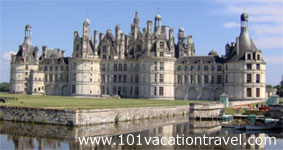Travel to Chambord France for Vacations

When a power conscious ruler, inveterate womanizer, and unstoppable visionary builds himself a hunting lodge then it must be something very special. Francis I (1494 – 1547) created a dream in stone when he built Chambord. A splendid work of fantasy, just like a tale from the Thousand and One Nights, the pompous royal hunting lodge consists of 440 rooms, 83 stairways, and overall dimension of 512 feet by 384 feet.
Constantly at war with the Habsburgs for control of Europe, Francis I, the king of France, developed his desire for a Renaissance chateaux while campaigning in Italy. It was important for him that he and his hunting friends should be as well cared for as they were at court. The southwest of the Sologne was considered the best location for such a chateau because the king could indulge his passion for hunting there. The area then was filled with wild boar and deer and remains one of the best places for hunting in France until today. Since the site chosen for the palace was marshland, building it was more of a nightmare than a dream, and when a plan to divert the Loire proved unsuccessful an entirely new river bed was dug at Cosson. It was essential to the king that the beauty of the chateau be reflected in water.
The plans for the chateau were drawn by Italian architects with the medieval style of French castle as their starting point. A monumental tower was sited in a large square structure to mimic the look-out tower of earlier settlements. This central feature remains the heart of the chateau today. A roof terrace is reached by means of a stairway, but not just any stairway. Part of the wonder of Chambord is this truly royal entrance through the escalier meridional. It is believed that the plans for this were drawn by Leonardo da Vinci. It is certainly true that Francis persuaded the original “Renaissance man” to come to the Loire and a love for architecture is one of the many things for which the master was renowned. Double helix stairways spiral in opposing directions, with deep windows that enable you to see both ascending and descending visitors without them meeting one another. This part of the chateau is also said to represent the globe, while rooms can on one floor are grouped in a Grecian circle.
The roof terrace was designed for festivities. The chateau served as the pedestal to the roof terrace rising above it like a giant centerpiece, with 365 chimneys, hundreds of spires, capitals, lanterns, and hell towers. People partied on the roof, played games there, walked around beneath parasols, got drunk, or looked out for returning hunting parties to see if they had been successful.
Francis I did not live to see his chateau completed. His successors reluctantly continued with the building of it, but it was Louis XIV who added some sparkle to Chambord when he rediscovered the place during the construction of his palace at Versailles. The French revolutionaries of 1789 were opposed to the grandeur of Chambord and they plundered the chateau of its furniture, wall hangings, and paintings. Under state ownership and stewardship, efforts have been made to restore Chambord’s decaying glory, partly funded by tourism. A visit to Chambord is an absolute must for anyone visiting the Loire.